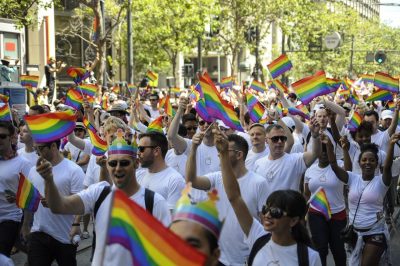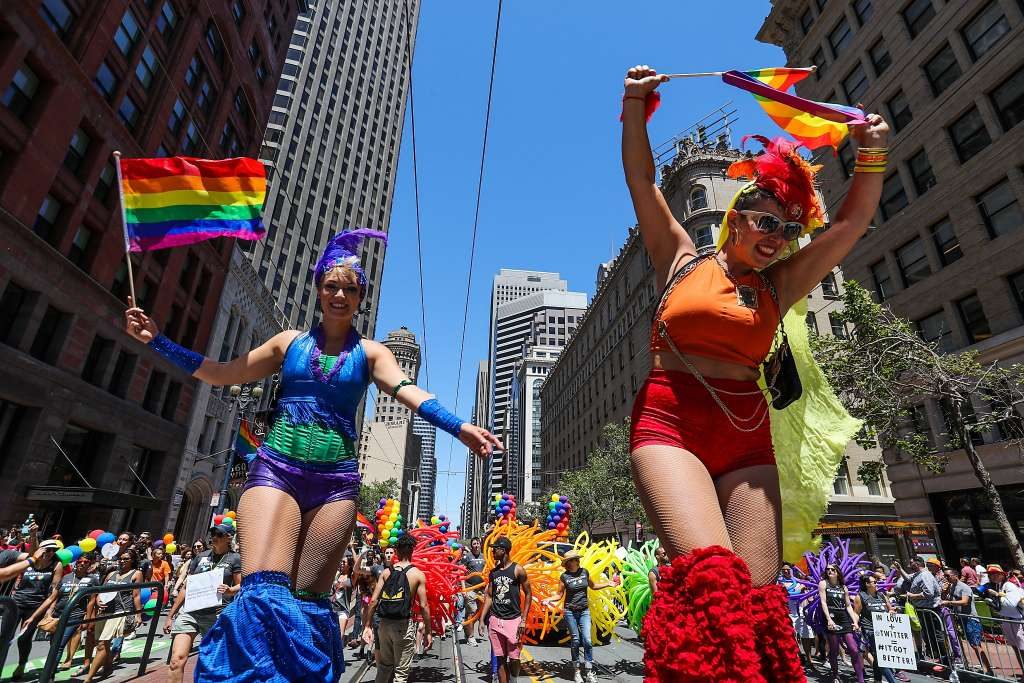Pride in San Francisco

San Francisco.
The security guard grinned at the bag with rheumy eyes. It had already begun to ache, the shoulder strap held down by writing material and a bottle of water. “Thank you, sir!”, came the emphatic note of approval. The bag had passed the test, as did its owner, who was frisked for anything unduly metallic. Nothing was to go wrong at this San Francisco Pride event, part of a weekend celebration that is a statement of assertion, defiance and sex.
Across the Civic Centre were tents and stalls: face and body painting; events for the gay community; information for the evening kick-on. There was some material on LGBT events, though historical information was sparse. (History tends to be, not so much another country here as another galaxy).
Source: SFGate
Sparse as well were the clothing items, which were less matters of fashion than anti-fashion, a poke-in-the-eye confidence starring flopping genitals with scrotal assuredness, painted nipples and clamps. There also seemed to be a high correlation between age and sheer, unshackled nakedness, leaving aside the rainbow ribbons, straps or cock socks.
The more weather worn veterans, brandishing their sugar alcoholic drinks, were very keen to let everyone know that this was their day of the year: nothing on, and thank you very much. But their nude forms belied an almost robotic routine: it was simply part of the course (as, indeed, it was the cause) to go uncovered for this occasion. To have been clothed would have not just seemed unthinkable, but obscene, a tribute to the nasty set of conformity.
Such an absence of wear revealed bodies milk white and translucent, pinking in the California sun. Dark shiny black figures, chocolate mixes, and tanned flesh reveal this to be a show of bods, rods and mammary glands, an aesthetic tyranny that is only challenged by the occasional hefty buffoon heaving himself about in torn underwear, or an enormous woman with a rump so expansive it signals boldness.
Other than that, it is an arms race of flesh and sexual projection. “Who is going to get sex tonight?” trumpets a hip hop artist inquiringly of his listening audience. Hoots are emitted and hands shoot up enthusiastically.
Such an event also provides a platform for ham activism, which tends to come a distant second to the entertainment value people seek. This is despite such calls as that from Robin Tyler writing in the Lesbian News in January 2017 in the aftermath of Donald Trump’s inauguration:
“Every Pride event in the USA and internationally should not have a Pride ‘Parade’ this year”, instead focusing on a “March against ignorance, prejudice, racism, misogyny, homophobia, climate change, nuclear threat, in other words, against Donald Trump!”
Musicians duly announce that they are “taking a stand against fascism in America”. Across a world, a “war is being waged on trans people.” Another act is far less political, and gets straight to the flesh in an uncomplicated fashion. “We want the hot bodies on stage now!” goes a band claiming to be the “hottest act in the US”. Do not let modesty muddy pride: if they don’t convince themselves, who will?
Each year is always marked by the same theme: love, sweet love. It is a search for the elusive perfection of harmony and self, battling insecurity by flaunting, screaming and hoping for the best. Songs about bullying and suicide are sung to ward off the demons who always threaten to crumple the vulnerable.
Behind the tolerance is a certain rehearsed, even strained quality. These are not safe times, though a Pride event is always edgy in the name of the tolerant persuasion. The policing hand is firm. “Safety monitors” roam. Since 2016, security measures for the San Francisco Pride Celebration have involved the discouraging of large unwieldy bags. A screening process was also implemented.
After the exhortative performances to tolerance conclude, and the flesh seems that much stretched, the time comes to veer through the Tenderloin, where the homeless and drug addled prove indifferent to the shaking noise of the Pride event. Identity politics in this part of SF is indifferent, even nonexistent. There is no directed noise in the name of sexual politics here but rambles of the non-existent life that fail to hit their mark. A bit of building graffiti makes a solemn promise: “World ends at 10; highlights at 11.”
Dr. Binoy Kampmark was a Commonwealth Scholar at Selwyn College, Cambridge. He lectures at RMIT University, Melbourne. Email: [email protected].
Featured image: The San Francisco Examiner


